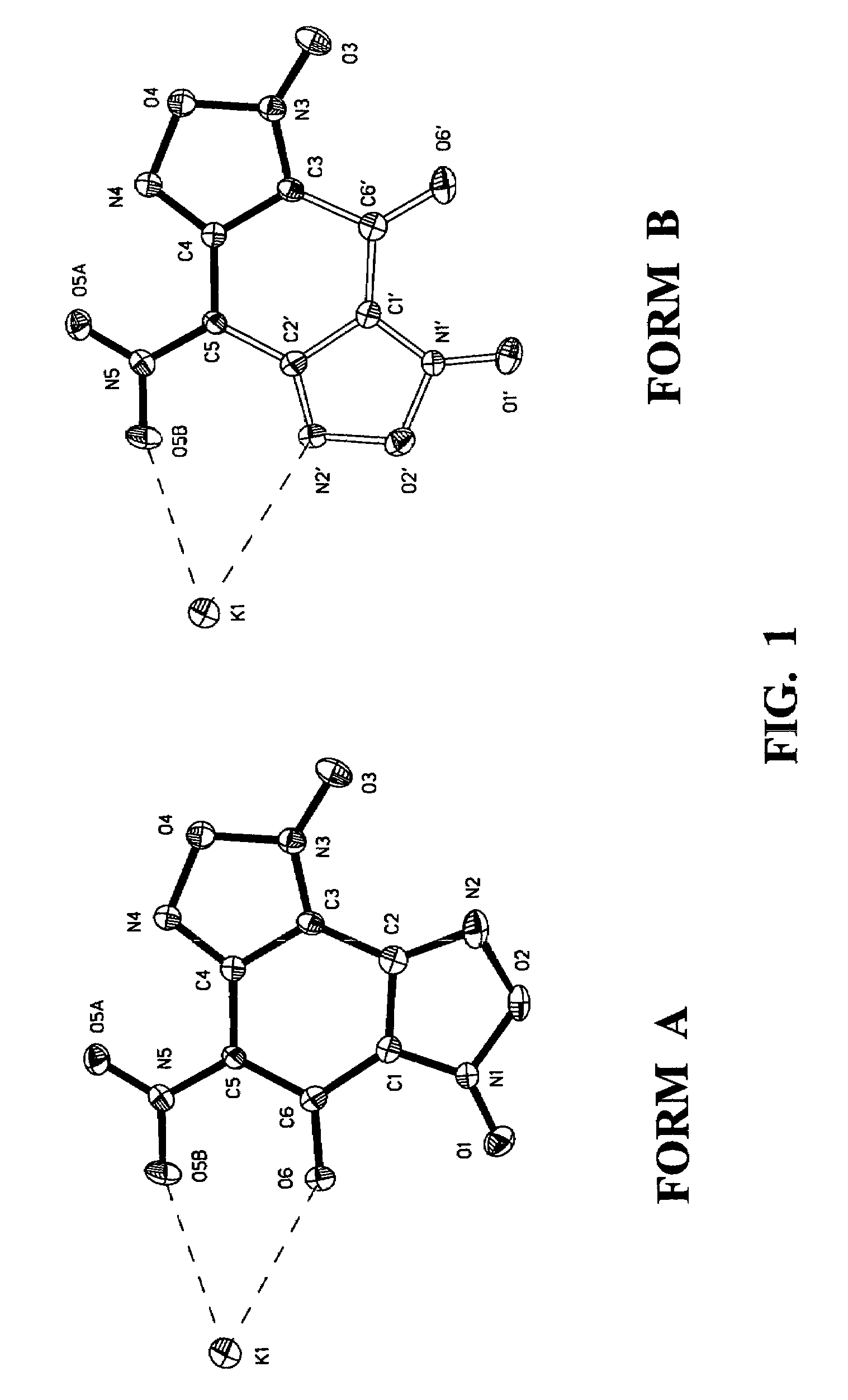Nitrobenzodifuroxan compounds, including their salts, and methods thereof
a technology of nitrobenzodifuroxan and compounds, applied in the field of nitrobenzodifuroxan compounds, can solve the problem that neither of these patents disclose the formation of a sensitive nitrobenzodifuroxan explosive composition
- Summary
- Abstract
- Description
- Claims
- Application Information
AI Technical Summary
Benefits of technology
Problems solved by technology
Method used
Image
Examples
example 1
Preparation of 3,5-diazido-2,4,6-trinitroanisole
[0041]A solution of 3,5-dichloro-2,4,6-trinitroanisole (1.50 g, 4.8 mmol) in dimethyl carbonate (15 mL) was stirred in a 100 mL one-neck round-bottomed flask. A solution of tetrabutylammonium bromide in water (4.4 mL) was added. [The solution of tetrabutylammonium bromide was prepared by dissolving it (0.30 g) in distilled water (30 mL) and using 4.4 mL of this solution]. A solution of sodium azide (0.90 g, 13.8 mmol) in distilled water (18 mL) was then added. The flask was stoppered and the mixture was stirred vigorously at room temp for 22 hr.
[0042]At this point, thin layer chromatography (TLC) was performed. TLC (using toluene / heptane 50 / 50 by volume as developer) of a small sample of the lower layer (diluted with acetone) indicated the reaction was complete (RF of diazido-product and the starting material are 0.46 and 0.62, respectively; note that the diazido product turns yellow after standing on the TLC plate). The lower yellow l...
example 2
Preparation of Methoxynitrobenzodifuroxan
[0043]The volatiles from the combined dimethyl carbonate yellow layer / extracts, from Example 1 above, were cautiously removed (without heating above room temperature) until the remaining volume of dimethyl carbonate was 10 mL. Toluene (40 mL) was added and the toluene / dimethyl carbonate solution was dried over anhydrous sodium sulfate overnight. The sodium sulfate was removed by filtration and the filter cake was washed with toluene (3×7 mL). The filtrate was heated in an oil bath near 100° C. for 7 hr. After 4.5 hr, TLC (toluene as developer) showed a small amount of the starting diazido compound. (The RF of methoxynitrobenzodifuroxan is about 0.64; the RF of the starting diazido compound is 0.77; the methoxynitrobenzodifuroxan product leaves a trail from the origin on the TLC plate, presumably due to hydrolysis.)
[0044]The reaction solution was allowed to cool to room temperature and stand overnight before the solution was decanted from a sm...
example 3
Preparation of Hydroxynitrobenzodifuroxan
[0045]Methoxynitrobenzodifuroxan (0.30 g, mp 149–152° C.), prepared as in Example 2 above, was dissolved by stirring in acetone (10 mL). Distilled water (2 mL) was added. (Some product precipitated from solution when the water was added, but re-dissolved as the mixture was heated towards 52–54° C.) The solution was held near 55° C. for 1.7 hr during which time it turned dark red brown. The volatiles were cautiously removed (without heating above room temperature) to give a red-brown solid (0.34 g), which was then stirred in distilled water (5 mL) at room temperature. A very small amount (0.01 g) of insoluble yellow solid was removed by filtration and washed with of distilled water (2×1.5 mL). The volume of the filtrate was 8 mL. The water was removed from one mL of the filtrate (without heating above room temperature) to give a light red solid, which had a melting point of 95° C. (with vigorous decomposition).
PUM
 Login to View More
Login to View More Abstract
Description
Claims
Application Information
 Login to View More
Login to View More - R&D
- Intellectual Property
- Life Sciences
- Materials
- Tech Scout
- Unparalleled Data Quality
- Higher Quality Content
- 60% Fewer Hallucinations
Browse by: Latest US Patents, China's latest patents, Technical Efficacy Thesaurus, Application Domain, Technology Topic, Popular Technical Reports.
© 2025 PatSnap. All rights reserved.Legal|Privacy policy|Modern Slavery Act Transparency Statement|Sitemap|About US| Contact US: help@patsnap.com



